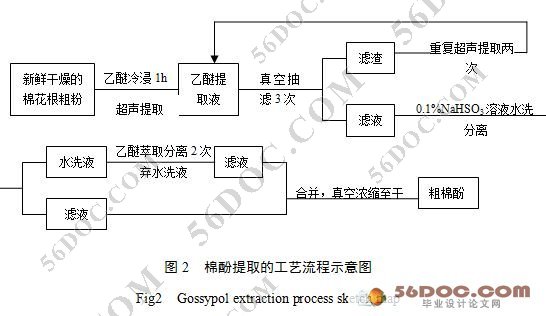摘 要:了解土壤微生物,黑曲霉,酵母菌与枯草芽孢杆菌对棉酚的分解情况。筛选能够提高棉酚提取效率的微生物。 酵母菌,枯草芽孢杆菌,黑曲霉与从土壤中分离纯化的10种微生物分别发酵处理棉花根皮粉末7天,并设置空白对照与自然处理对照,第七天干燥后用乙醚超生萃取提取棉酚,采用紫外分光光度法在360 nm波长处测定棉酚含量并比较。 10种土壤微生物分别处理后其棉酚产率均介于1.066 %-1.187 %,变化较小。酵母菌与黑曲霉处理后棉酚产率分别是1.373 %与1.441 %,枯草芽孢杆菌为0.892 %。 此10种土壤中的微生物处理棉根几乎不影响棉酚提取效率,且产率接近,预测为同一种微生物。酵母菌与黑曲霉能有效增加棉酚提取效率,而枯草芽孢杆菌则降低棉酚提取效率。
关键词:棉根皮;棉酚;微生物处理; 提取效率;
The Influence Of Microbial Processing Cotton Root To The Efficiency Of Gossypol Extraction
Abstract:Objective : Realizing the decomposition condition of gossypol from microbial Aspergillus niger , Bacillus subtilis (Ehrenberg) Cohn and Yeast in order to filter the microbial that can increase the extraction efficiency of gossypol.
Methods: Fermenting the cotton root from Yeast,Bacillus subtilis (Ehrenberg) Cohn, Aspergillus niger and ten different microbial from soil separately in seven days, and setting up the blank space contrast and natural condition contrast. After drying it, using Ether ultrasonic extraction filter the gossypol. At last, measuring and comparing the gossypol’s contents at the 360 nm wavelength, this used the ultraviolet spectrophotometric method.
Results: The gossypol yield change is small after ten different microbial from soil processing; the result is between 1.066 %-1.187 %.After Yeast,Bacillus subtilis (Ehrenberg) Cohn, Aspergillus niger, blank control , natural condition control processing separately ,their gossypol yield reached to 1.373 %, 0.892 %, 1.341 %,1.125 %,1.119 %.
Conclusion: These ten microbial from soil processing cotton coot nearly no effect on the extraction efficiency of gossypol, meanwhile, it closed to the product rate. So I predict that it is a microbial. Yeast and Aspergillus niger can increase gossypol extraction effectively. While, Bacillus subtilis cohn can decrease it.
Key words: cotton root; gossypol; microbial processing; extraction efficiency
本次实验菌落均取自土壤微生物中分离纯化或实验室中单菌落,由于样本接种菌落前灭菌,所以排除了棉花根内生菌对棉酚提取效率的影响,除两个对照外其他样本均只受一种菌落影响,增加自然处理对照能够更加客观的分析实验结果。
由于不同菌落处理过的棉根棉酚产率各不相同,可以看出不同微生物处理棉根对棉酚提取效率是有不同影响。对照1与对照2棉酚产率几乎没变,分析出棉根皮内生菌对棉皮中棉酚提取效率没有影响;编号1至编号10之间相比棉酚产率变化很小,可看做实验误差导致,且其菌落形态相似,由此可以预测这10种菌落可能是同一种菌;编号1-10与对照1相比较棉酚产率变化量也很小,可以初步分析出土壤中微生物对棉酚基本没有分解或转化作用,这也许是棉酚能在棉根皮中保存的原因之一;编号11与编号13与对照1相比棉酚产率增长明显,说明酵母菌与黑曲霉能够提高棉酚的提取效率,可能是其产生的酶促进了棉酚的释放;编号12与对照1相比棉酚产率降低,说明枯草芽孢杆菌能够减少棉酚提取效率,可能是其产生的酶抑制了棉酚的释放或者分解或转化了释放的棉酚。


目 录 10000字
摘 要 1
关键词 1
1 前言 2
1.1 棉酚化学结构及理化性质 2
1.2 棉酚的作用 3
1.2.1 避孕药物棉酚 3
1.2.2 棉酚的抗肿瘤作用 4
1.2.3 棉酚的其他作用 5
1.3 棉皮中棉酚的提取及含量测定 6
1.3.1 棉皮中棉酚的提取方法 6
1.3.2 棉酚含量的测定方法 6
1.4 微生物分离方法 7
1.4.1 接种方法 7
1.4.2 分离纯化 7
1.5 研究目的 8
2 实验内容与方法 8
2.1 实验材料 8
2.1.1 仪器和试剂与药品 8
2.1.2 培养基 8
2.2 实验方法 9
2.2.1 微生物的获取 9
2.2.2 微生物对棉花根的发酵处理 9
2.2.3 棉酚的提取 9
3 结果与分析 10
3.1 分离纯化得到的微生物图片与特征形态 10
3.2 微生物处理棉花根粉末图片 12
3.3 微生物处理对棉酚提取效率的影响 13
3.4 结果分析 13
4 结论 13
参考文献 14
致 谢 15
|


